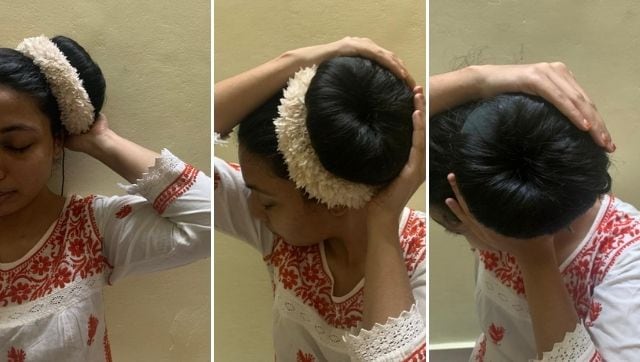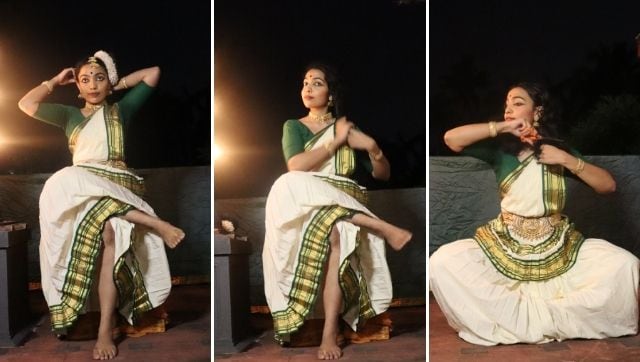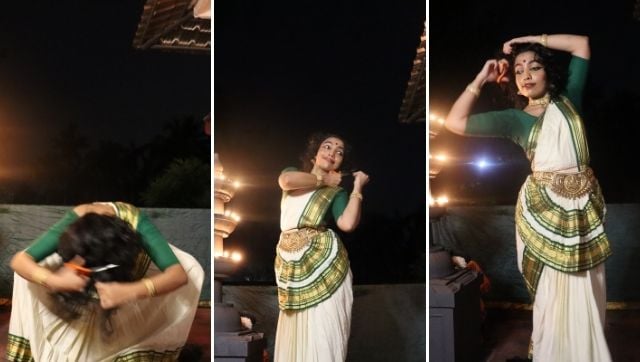The questions perhaps summarised in the two images above is where does the ‘mohini’ lie, and what does the term ‘mohini’ capture in the troubled history of the form of Mohiniyattam. Mohiniyattam, as a form, originated in Kerala, and was historically known as ‘Tevidicchi Aattam’, which later came to be known as ‘Mohini’ Aattam. The art form has been close to me for most of my life since my childhood. But, it is only recently that I have been struggling with some questions while doing critical reading on its practice. My protest performance action took place on 18 December 2020, for a duration of 12 minutes. It was titled ‘Aattam’. My performance action was to cut my hair as I moved and performed Mohiniyattam. Classical dances have certain body ideals created for themselves, and one of them is the long hair or a stipulated hair length for the female performer that qualifies her to wear the costume. What does the hair — especially the long hair attached to the body of the woman — imply? When the institutionalisation of Mohiniyattam through Kalamandalam took place in the 1940s, there were several changes done to the form, including body technicalities and movements which were ‘corrected’ to make it ‘fit in’ to a particular framework of the body for the female performer. [caption id=“attachment_9231071” align=“alignnone” width=“640”]
 The author’s hair before her ‘Aattam’ performance[/caption] In the 1960s, the repertoire of Mohiniyattam also witnessed a major change. Dance scholar Kanak Rele, while writing on Mohiniyattam, described the choreography of ‘Mukutthi’ (nose-pin) as vulgar. This item depicts the female performer telling the audience about her lost nose-pin, and she goes on to ask if anybody has seen the same. Towards the end, the performer spots a spectator and complains that they have stolen her nose-pin. This item involves the female performer interacting with the usually male spectator(s) about a bodily ornament which is lost. The same ‘vulgarity’ is also mentioned by her for the item ‘Chandanam’, where the sakhi applies sandalwood paste on the body of the heroine. These items were perceived as being problematic in the repertoire, in terms of the prominent sexuality that they portrayed, or in terms of the seeming lack of social ‘conditioning’ displayed by the women performing them, which was considered strictly undesirable in the 1960s. As a result, changes done to the form, including the elements erased and added, had more to do with defining the ‘woman’ portrayed, the performance of a ‘woman’ in society, what she should look like, besides a list of other ideals prescribed for the woman’s identity that would be fed to the audience. Who is it that we portray through our performances? Is it necessary for the performer to have long hair? Who made these rules and why were they made the way they were? The location of my performance was Kerala and hence, it felt even closer to my heart as this is where I started dancing and this is also where the institutionalisation of Mohiniyattam had occurred. The main materials used for the performance were the costume and components needed for Mohiniyattam, my ghungroos and a pair of scissors. [caption id=“attachment_9231101” align=“alignnone” width=“640”]
The author’s hair before her ‘Aattam’ performance[/caption] In the 1960s, the repertoire of Mohiniyattam also witnessed a major change. Dance scholar Kanak Rele, while writing on Mohiniyattam, described the choreography of ‘Mukutthi’ (nose-pin) as vulgar. This item depicts the female performer telling the audience about her lost nose-pin, and she goes on to ask if anybody has seen the same. Towards the end, the performer spots a spectator and complains that they have stolen her nose-pin. This item involves the female performer interacting with the usually male spectator(s) about a bodily ornament which is lost. The same ‘vulgarity’ is also mentioned by her for the item ‘Chandanam’, where the sakhi applies sandalwood paste on the body of the heroine. These items were perceived as being problematic in the repertoire, in terms of the prominent sexuality that they portrayed, or in terms of the seeming lack of social ‘conditioning’ displayed by the women performing them, which was considered strictly undesirable in the 1960s. As a result, changes done to the form, including the elements erased and added, had more to do with defining the ‘woman’ portrayed, the performance of a ‘woman’ in society, what she should look like, besides a list of other ideals prescribed for the woman’s identity that would be fed to the audience. Who is it that we portray through our performances? Is it necessary for the performer to have long hair? Who made these rules and why were they made the way they were? The location of my performance was Kerala and hence, it felt even closer to my heart as this is where I started dancing and this is also where the institutionalisation of Mohiniyattam had occurred. The main materials used for the performance were the costume and components needed for Mohiniyattam, my ghungroos and a pair of scissors. [caption id=“attachment_9231101” align=“alignnone” width=“640”]
 The different stages of the author’s haircut during her performance[/caption] Choosing the scissors made me feel anxious, as it had to be used to cut my hair perfectly during my performance. I wanted to go ahead with the regular pair of home scissors instead of the parlour ones; after making my choice, I even cut a small portion of my hair to see if it would work swiftly and smoothly during the rehearsals. I had chosen to perform the composition ‘Jeeva’, which is the final piece in the Sopana repertoire of Mohiniyattam. It depicts the union of Shiva and Shakti to denote salvation. The rhythm of the music along with the vaythari increase arithmetically and acquire pace at the end. This paired well with my feelings of frustration and struggles with the form, as I pondered over questions of grammar and the body, the push to simply cut my hair and feel liberated, unlike all the times when I refrained from doing so in anticipation of a dance performance and the fear of missing an opportunity. The space was set up traditionally with lamps lit in the evening. It also rendered a sense of questioning of some traditions created by the institutions of Mohiniyattam, and how using its very own norms, the ‘cut’ should evolve and flow to ‘broaden’ (my sense of) the form. The title of the performance was ‘Aattam’. The term ‘tevidicchi’ (from the form’s erstwhile name ‘Tevidicchi Aattam’) is currently used derogatorily in Malayalam, which is one of the results of the upper-caste appropriation of the art form. The devadasis performed the dance of Tevidicchi Aattam in Kerala, which was later followed by upper caste appropriation of it with changes made to the art form, including its renaming and introduction of the figure of ‘mohini’. I still do not know if using the word ‘mohini’ with aattam feels right for me, and hence, I wanted to only use the term ‘aattam’ meaning ‘movement’. If I should be using the term ‘Mohini’-aattam anymore is a question I continue to ask myself. However, this was also my first ever performance for an audience where I felt liberated in questioning a tiny aspect of what ‘Mohini’-aattam is. [caption id=“attachment_9231121” align=“alignnone” width=“640”]
The different stages of the author’s haircut during her performance[/caption] Choosing the scissors made me feel anxious, as it had to be used to cut my hair perfectly during my performance. I wanted to go ahead with the regular pair of home scissors instead of the parlour ones; after making my choice, I even cut a small portion of my hair to see if it would work swiftly and smoothly during the rehearsals. I had chosen to perform the composition ‘Jeeva’, which is the final piece in the Sopana repertoire of Mohiniyattam. It depicts the union of Shiva and Shakti to denote salvation. The rhythm of the music along with the vaythari increase arithmetically and acquire pace at the end. This paired well with my feelings of frustration and struggles with the form, as I pondered over questions of grammar and the body, the push to simply cut my hair and feel liberated, unlike all the times when I refrained from doing so in anticipation of a dance performance and the fear of missing an opportunity. The space was set up traditionally with lamps lit in the evening. It also rendered a sense of questioning of some traditions created by the institutions of Mohiniyattam, and how using its very own norms, the ‘cut’ should evolve and flow to ‘broaden’ (my sense of) the form. The title of the performance was ‘Aattam’. The term ‘tevidicchi’ (from the form’s erstwhile name ‘Tevidicchi Aattam’) is currently used derogatorily in Malayalam, which is one of the results of the upper-caste appropriation of the art form. The devadasis performed the dance of Tevidicchi Aattam in Kerala, which was later followed by upper caste appropriation of it with changes made to the art form, including its renaming and introduction of the figure of ‘mohini’. I still do not know if using the word ‘mohini’ with aattam feels right for me, and hence, I wanted to only use the term ‘aattam’ meaning ‘movement’. If I should be using the term ‘Mohini’-aattam anymore is a question I continue to ask myself. However, this was also my first ever performance for an audience where I felt liberated in questioning a tiny aspect of what ‘Mohini’-aattam is. [caption id=“attachment_9231121” align=“alignnone” width=“640”]
 The author cuts her hair on stage during her ‘Aattam’ performance[/caption] Choreographing movements incorporating spaces for cutting my hair sounded like an exciting prospect. Mohiniyattam is known for its movements — the body of the performer moves constantly and it stops only very minimally. The cuts, hence, had to initially be done during those little stops. However, slowly, both the ‘chuzhippu’ (body movements) and the cuts had to occur simultaneously. This challenge felt like it answered my questions in so many senses — it felt like there are possibilities and answers that I could find in the movement or the grammar of the form itself. Although the scissors ‘cut’ the movement, they also moved with the movement and provided me with both questions and answers for further research. Before the performance, I only had feelings of anxiety regarding the ‘cuts’, both for my hair and my performance that would get interjected by the action, as these breaks in a space of classical dance meant something. Besides my own introspection, I also had to prepare myself for numerous questions on why I had cut my hair and why was it that short from people I would be facing the next day. In the community in which I live, a woman cutting her hair short is perceived as a questionable gesture as it invites queries on an aspect of the female body that is highly revered. Besides, there were also anxieties regarding the internet connection that would be used for streaming my live performance, and also the cloudy and rainy weather of the place where I was staying. But thankfully, it did not rain that day. It was also one of my first experiences of performing Mohiniyattam live online.
The author cuts her hair on stage during her ‘Aattam’ performance[/caption] Choreographing movements incorporating spaces for cutting my hair sounded like an exciting prospect. Mohiniyattam is known for its movements — the body of the performer moves constantly and it stops only very minimally. The cuts, hence, had to initially be done during those little stops. However, slowly, both the ‘chuzhippu’ (body movements) and the cuts had to occur simultaneously. This challenge felt like it answered my questions in so many senses — it felt like there are possibilities and answers that I could find in the movement or the grammar of the form itself. Although the scissors ‘cut’ the movement, they also moved with the movement and provided me with both questions and answers for further research. Before the performance, I only had feelings of anxiety regarding the ‘cuts’, both for my hair and my performance that would get interjected by the action, as these breaks in a space of classical dance meant something. Besides my own introspection, I also had to prepare myself for numerous questions on why I had cut my hair and why was it that short from people I would be facing the next day. In the community in which I live, a woman cutting her hair short is perceived as a questionable gesture as it invites queries on an aspect of the female body that is highly revered. Besides, there were also anxieties regarding the internet connection that would be used for streaming my live performance, and also the cloudy and rainy weather of the place where I was staying. But thankfully, it did not rain that day. It was also one of my first experiences of performing Mohiniyattam live online.
What cutting my own hair during a Mohiniyattam performance taught me about gender politics within the form
Sreelekshmi Namboothiri
• February 1, 2021, 12:29:51 IST
Classical dances have certain body ideals created for themselves, and one of them is the long hair or a stipulated hair length for the female performer that qualifies her to wear the costume. What does the hair — especially the long hair attached to the body of the woman — imply?
Advertisement
)
The thought of re-narrating a traditional composition like ‘Jeeva’ through a personal lens was extremely liberating and joyful, as it served my purpose of dancing. ‘Jeeva’ conventionally means the union of Shiva and Shakti, but with my prevailing state of emotions, it only stood for exploring one way of liberation in my practice, which would reduce the distance between my body and the form, as a result of which this approach felt more correct personally. I harboured mixed feelings when I used the very frame that restricted me from cutting my hair to actually cut my hair, and by the end, I felt happy and truly free. Getting ready for the performance felt easier this time; it felt like I had the freedom to find my comfort in choosing and forsaking certain aspects of the costume. Applying make-up this time felt different from the other times. As I applied kajal and used the eyebrow pencil, I felt different. Instead of catering to a specific ideal of beauty, I followed my instincts and highlighted the natural shape of my brows. When I did pushes opposite to the ones prescribed by Mohiniyattam grammar, the form only felt closer to my body. One may also want to note the differences in the traditional costumes for ‘men’ and ‘women’. At a time when we speak of genders as non-binary entities, how do we portray the same in dance? Is it then necessary for women to don the ‘female’ costumes? What did the costumes suggest in terms of gender performativity, and the form’s geo-socio-political locations? Additionally, did all these aspects strip Mohiniyattam of its essence or ‘Mohiniyattam-ness’? I did not think so.
As I found some answers after the performance regarding how body ideals were different for practitioners of different genders, and how that has been ignored and problematised, I believe what I need to think more about now is the notion of costuming in the traditional art forms. What do the costumes say, and how should they evolve? Unlike in certain traditional forms like Kathakali, where little character differentiation was present, forms like Mohiniyattam portray characters through body movements. Therefore as of now, I would like to locate my core of ‘Mohini’attam in the body movements primarily. Perhaps even if I wore something else for the performance, it would still remain ‘Mohini’attam for me. Which also made me think that maybe the primary core for every practitioner is different. One may argue that forms require a certain kind of costume for their performance, but the costume should focus on the ‘making’ or the process — like the process of doing the hair or preparing the body for a performance. However, the same principle should not be attached to the individual bodies of the performers outside of their performances, thereby creating boundaries of entry and exit into the field of performing arts.
If we observe the classical dances closely, we will notice how the boundaries are also different for different genders. Male practitioners usually recount their experiences of quitting their practice only because they had to shave their facial hair every time before a performance. Where do we, then, place these notions of the demands made on a body with respect to costuming in each form? Can the costuming facilitate changes to accommodate the comforts of individual performers? Or should the mandates in the costumes themselves — like the requirement of long hair, golden borders on the dress and the ornaments — be questioned too in order to investigate the histories of how they were instituted and who instituted them? As we were being workshopped by the faculty for the performance protest action, I was left mulling over the question of if I continued to perform such pieces, what would be left of the form or would it lead ways to an older/newer form? — All images courtesy Shivani Rai
End of Article